Fig and Olive Capital: Financial Analysis
VerifiedAdded on 2020/05/16
|18
|2761
|205
AI Summary
This assignment presents a set of financial records for 'Fig and Olive Capital'. Students are tasked with analyzing these records to understand the company's financial performance. The analysis involves examining various accounts such as revenue, expenses, profit, and capital contributions. The provided data includes income statements, balance sheets, and a summary of drawings by the owner. Students will gain insights into key financial ratios and the overall financial health of Fig and Olive Capital.
Contribute Materials
Your contribution can guide someone’s learning journey. Share your
documents today.
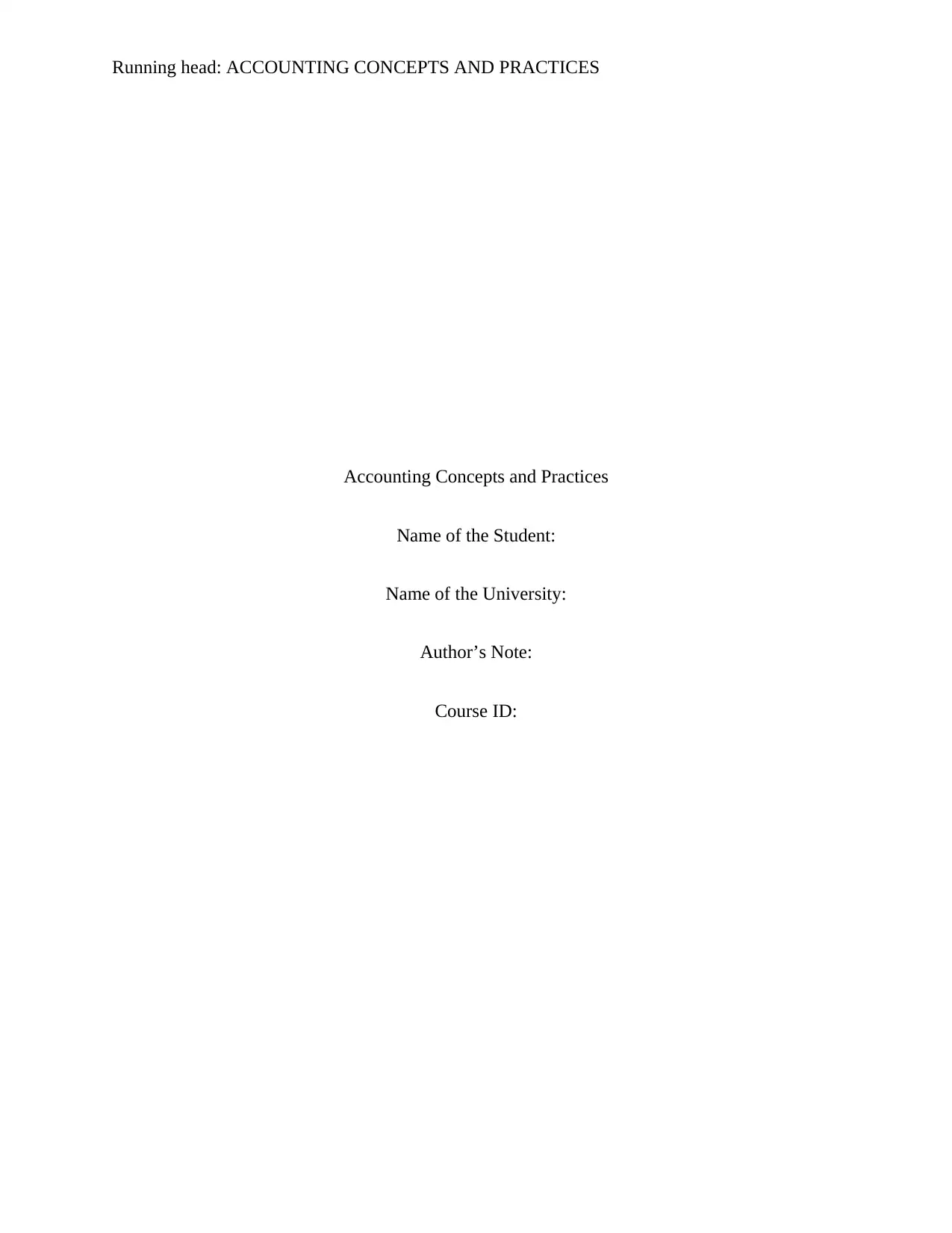
Running head: ACCOUNTING CONCEPTS AND PRACTICES
Accounting Concepts and Practices
Name of the Student:
Name of the University:
Author’s Note:
Course ID:
Accounting Concepts and Practices
Name of the Student:
Name of the University:
Author’s Note:
Course ID:
Secure Best Marks with AI Grader
Need help grading? Try our AI Grader for instant feedback on your assignments.
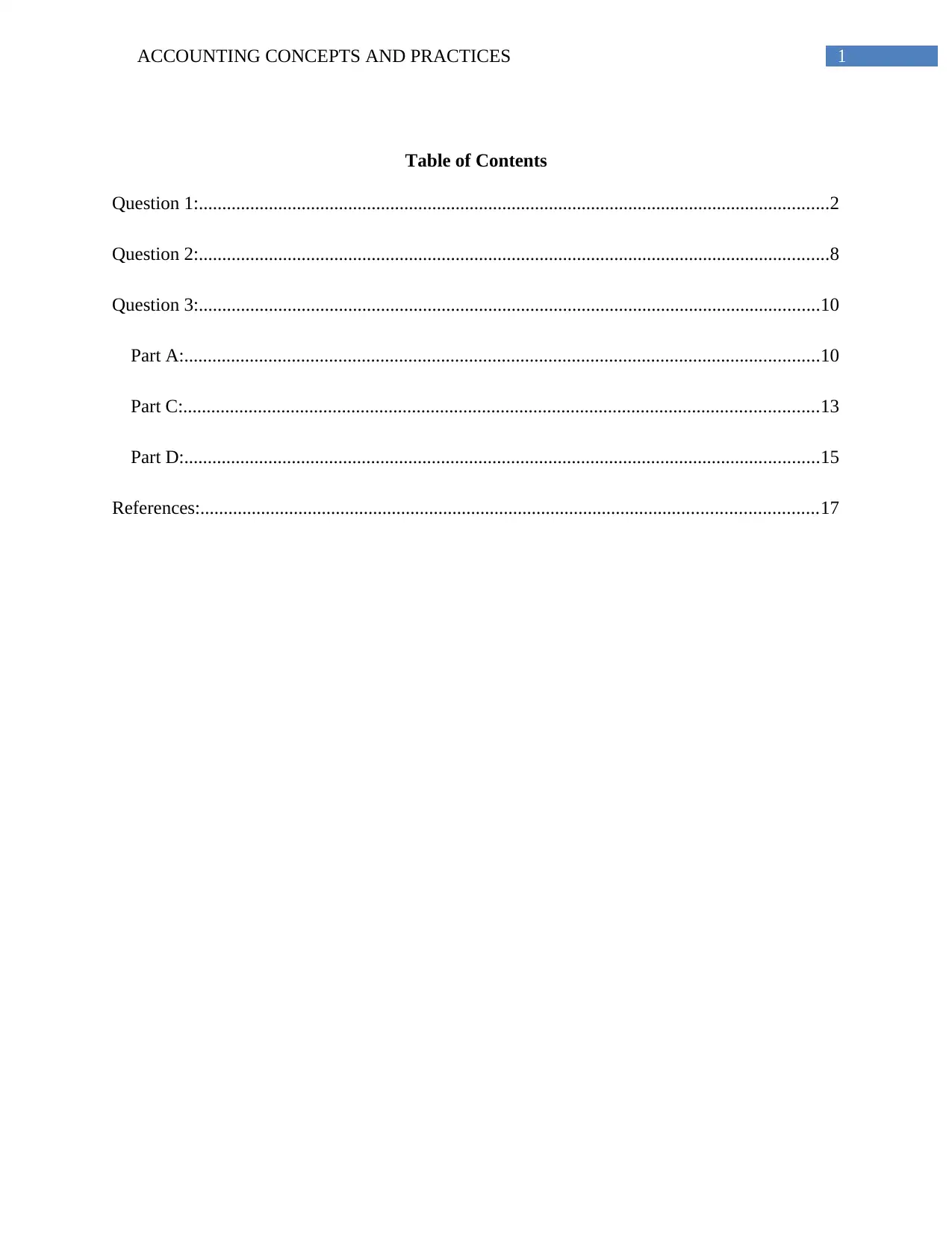
1ACCOUNTING CONCEPTS AND PRACTICES
Table of Contents
Question 1:.......................................................................................................................................2
Question 2:.......................................................................................................................................8
Question 3:.....................................................................................................................................10
Part A:........................................................................................................................................10
Part C:........................................................................................................................................13
Part D:........................................................................................................................................15
References:....................................................................................................................................17
Table of Contents
Question 1:.......................................................................................................................................2
Question 2:.......................................................................................................................................8
Question 3:.....................................................................................................................................10
Part A:........................................................................................................................................10
Part C:........................................................................................................................................13
Part D:........................................................................................................................................15
References:....................................................................................................................................17
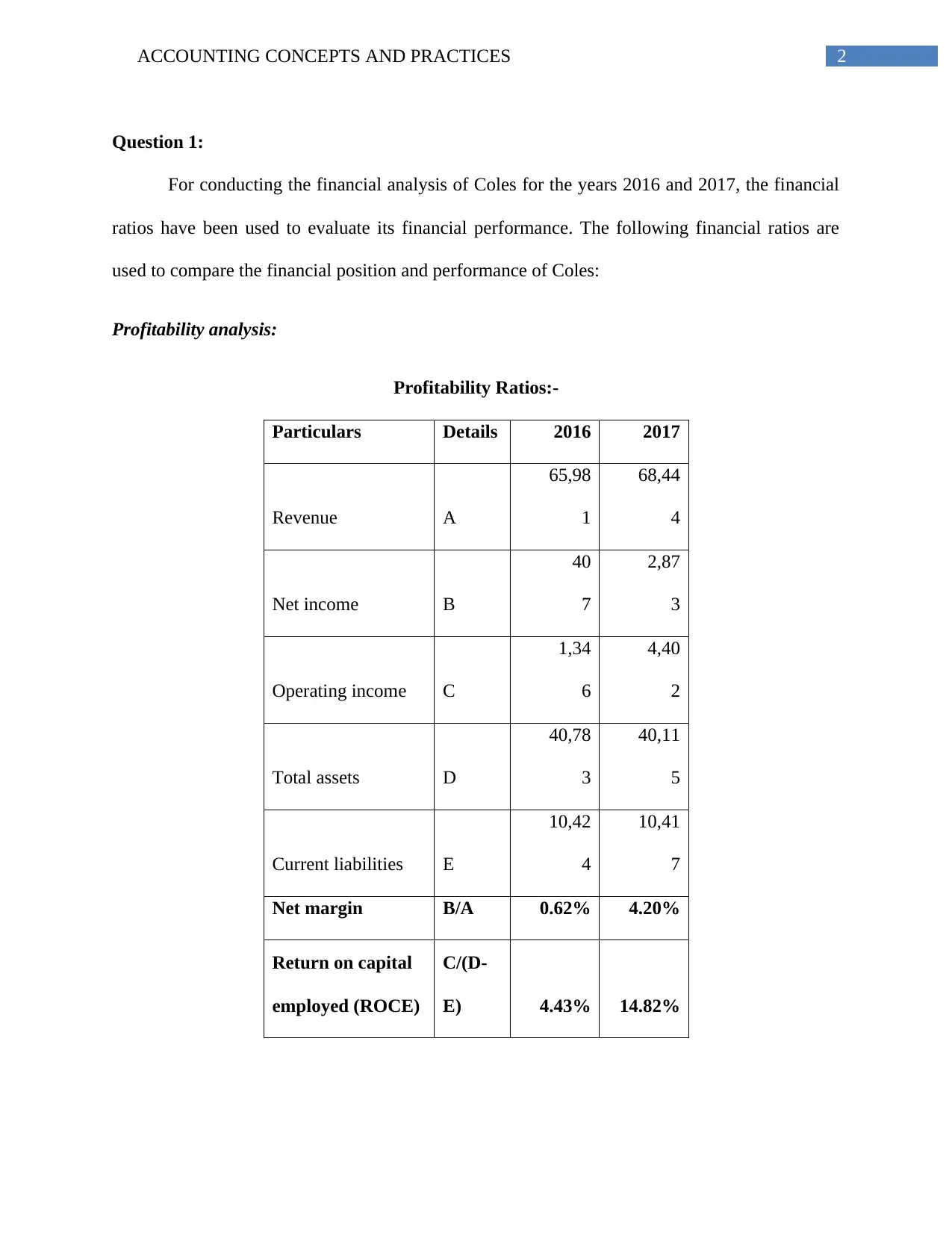
2ACCOUNTING CONCEPTS AND PRACTICES
Question 1:
For conducting the financial analysis of Coles for the years 2016 and 2017, the financial
ratios have been used to evaluate its financial performance. The following financial ratios are
used to compare the financial position and performance of Coles:
Profitability analysis:
Profitability Ratios:-
Particulars Details 2016 2017
Revenue A
65,98
1
68,44
4
Net income B
40
7
2,87
3
Operating income C
1,34
6
4,40
2
Total assets D
40,78
3
40,11
5
Current liabilities E
10,42
4
10,41
7
Net margin B/A 0.62% 4.20%
Return on capital
employed (ROCE)
C/(D-
E) 4.43% 14.82%
Question 1:
For conducting the financial analysis of Coles for the years 2016 and 2017, the financial
ratios have been used to evaluate its financial performance. The following financial ratios are
used to compare the financial position and performance of Coles:
Profitability analysis:
Profitability Ratios:-
Particulars Details 2016 2017
Revenue A
65,98
1
68,44
4
Net income B
40
7
2,87
3
Operating income C
1,34
6
4,40
2
Total assets D
40,78
3
40,11
5
Current liabilities E
10,42
4
10,41
7
Net margin B/A 0.62% 4.20%
Return on capital
employed (ROCE)
C/(D-
E) 4.43% 14.82%
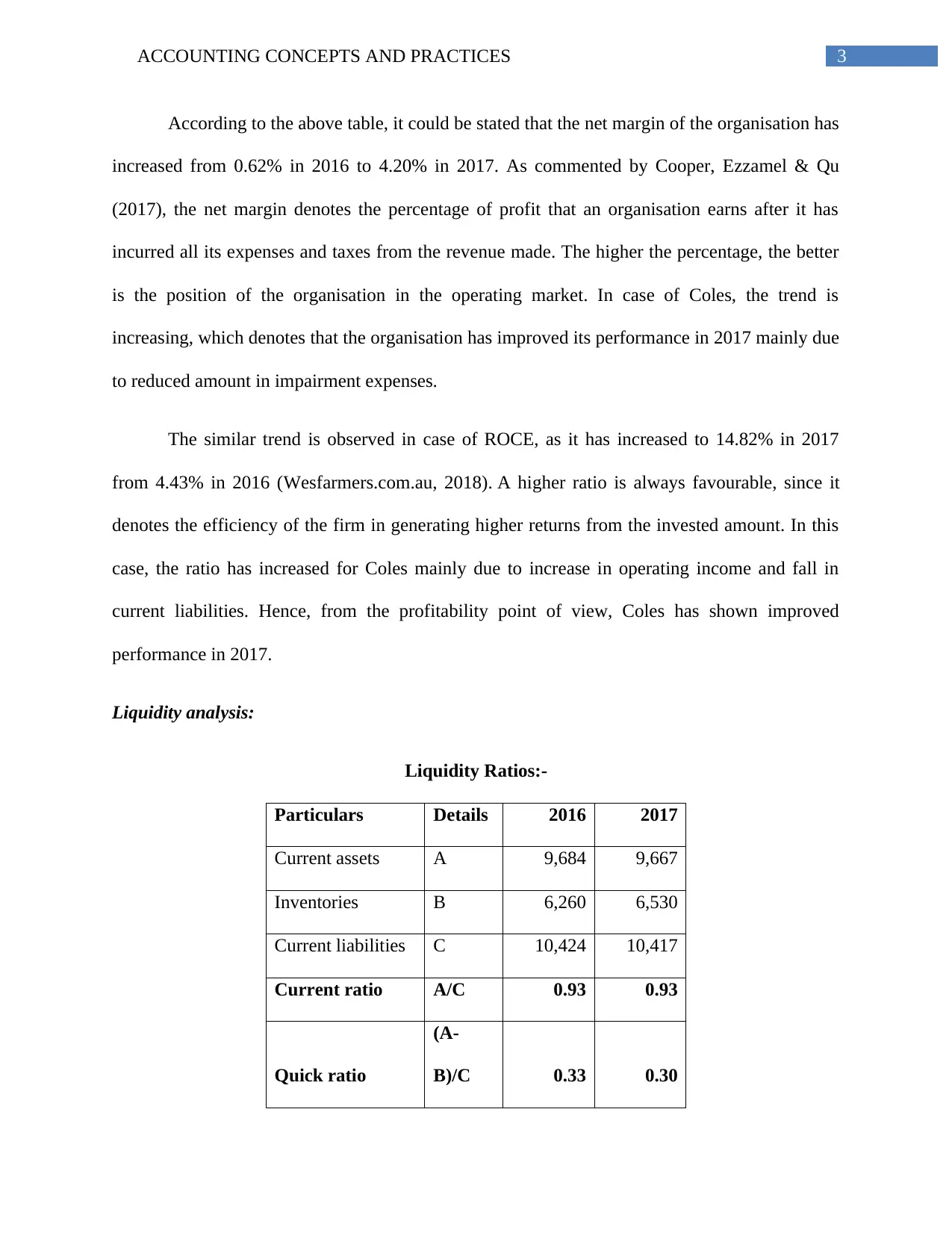
3ACCOUNTING CONCEPTS AND PRACTICES
According to the above table, it could be stated that the net margin of the organisation has
increased from 0.62% in 2016 to 4.20% in 2017. As commented by Cooper, Ezzamel & Qu
(2017), the net margin denotes the percentage of profit that an organisation earns after it has
incurred all its expenses and taxes from the revenue made. The higher the percentage, the better
is the position of the organisation in the operating market. In case of Coles, the trend is
increasing, which denotes that the organisation has improved its performance in 2017 mainly due
to reduced amount in impairment expenses.
The similar trend is observed in case of ROCE, as it has increased to 14.82% in 2017
from 4.43% in 2016 (Wesfarmers.com.au, 2018). A higher ratio is always favourable, since it
denotes the efficiency of the firm in generating higher returns from the invested amount. In this
case, the ratio has increased for Coles mainly due to increase in operating income and fall in
current liabilities. Hence, from the profitability point of view, Coles has shown improved
performance in 2017.
Liquidity analysis:
Liquidity Ratios:-
Particulars Details 2016 2017
Current assets A 9,684 9,667
Inventories B 6,260 6,530
Current liabilities C 10,424 10,417
Current ratio A/C 0.93 0.93
Quick ratio
(A-
B)/C 0.33 0.30
According to the above table, it could be stated that the net margin of the organisation has
increased from 0.62% in 2016 to 4.20% in 2017. As commented by Cooper, Ezzamel & Qu
(2017), the net margin denotes the percentage of profit that an organisation earns after it has
incurred all its expenses and taxes from the revenue made. The higher the percentage, the better
is the position of the organisation in the operating market. In case of Coles, the trend is
increasing, which denotes that the organisation has improved its performance in 2017 mainly due
to reduced amount in impairment expenses.
The similar trend is observed in case of ROCE, as it has increased to 14.82% in 2017
from 4.43% in 2016 (Wesfarmers.com.au, 2018). A higher ratio is always favourable, since it
denotes the efficiency of the firm in generating higher returns from the invested amount. In this
case, the ratio has increased for Coles mainly due to increase in operating income and fall in
current liabilities. Hence, from the profitability point of view, Coles has shown improved
performance in 2017.
Liquidity analysis:
Liquidity Ratios:-
Particulars Details 2016 2017
Current assets A 9,684 9,667
Inventories B 6,260 6,530
Current liabilities C 10,424 10,417
Current ratio A/C 0.93 0.93
Quick ratio
(A-
B)/C 0.33 0.30
Secure Best Marks with AI Grader
Need help grading? Try our AI Grader for instant feedback on your assignments.
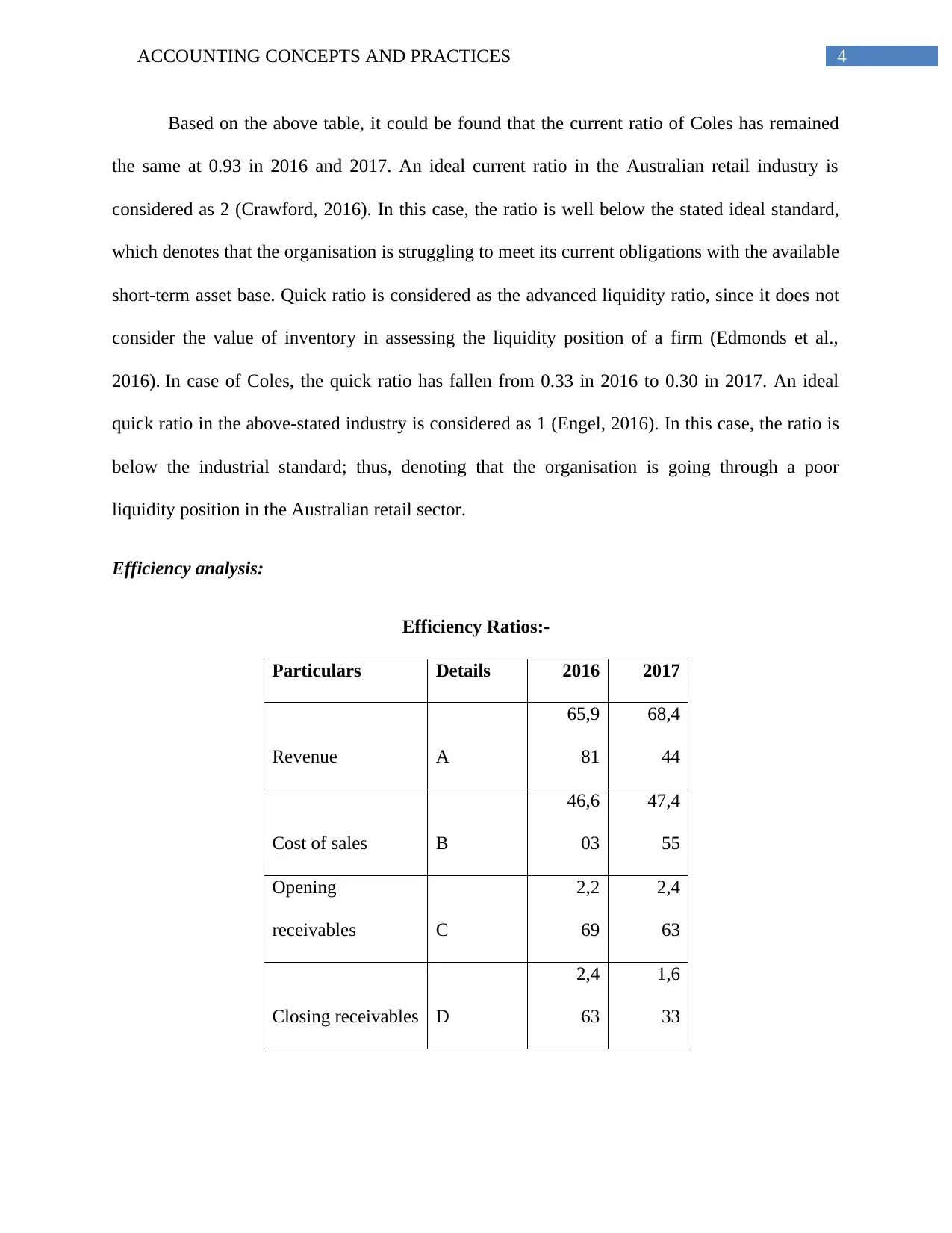
4ACCOUNTING CONCEPTS AND PRACTICES
Based on the above table, it could be found that the current ratio of Coles has remained
the same at 0.93 in 2016 and 2017. An ideal current ratio in the Australian retail industry is
considered as 2 (Crawford, 2016). In this case, the ratio is well below the stated ideal standard,
which denotes that the organisation is struggling to meet its current obligations with the available
short-term asset base. Quick ratio is considered as the advanced liquidity ratio, since it does not
consider the value of inventory in assessing the liquidity position of a firm (Edmonds et al.,
2016). In case of Coles, the quick ratio has fallen from 0.33 in 2016 to 0.30 in 2017. An ideal
quick ratio in the above-stated industry is considered as 1 (Engel, 2016). In this case, the ratio is
below the industrial standard; thus, denoting that the organisation is going through a poor
liquidity position in the Australian retail sector.
Efficiency analysis:
Efficiency Ratios:-
Particulars Details 2016 2017
Revenue A
65,9
81
68,4
44
Cost of sales B
46,6
03
47,4
55
Opening
receivables C
2,2
69
2,4
63
Closing receivables D
2,4
63
1,6
33
Based on the above table, it could be found that the current ratio of Coles has remained
the same at 0.93 in 2016 and 2017. An ideal current ratio in the Australian retail industry is
considered as 2 (Crawford, 2016). In this case, the ratio is well below the stated ideal standard,
which denotes that the organisation is struggling to meet its current obligations with the available
short-term asset base. Quick ratio is considered as the advanced liquidity ratio, since it does not
consider the value of inventory in assessing the liquidity position of a firm (Edmonds et al.,
2016). In case of Coles, the quick ratio has fallen from 0.33 in 2016 to 0.30 in 2017. An ideal
quick ratio in the above-stated industry is considered as 1 (Engel, 2016). In this case, the ratio is
below the industrial standard; thus, denoting that the organisation is going through a poor
liquidity position in the Australian retail sector.
Efficiency analysis:
Efficiency Ratios:-
Particulars Details 2016 2017
Revenue A
65,9
81
68,4
44
Cost of sales B
46,6
03
47,4
55
Opening
receivables C
2,2
69
2,4
63
Closing receivables D
2,4
63
1,6
33
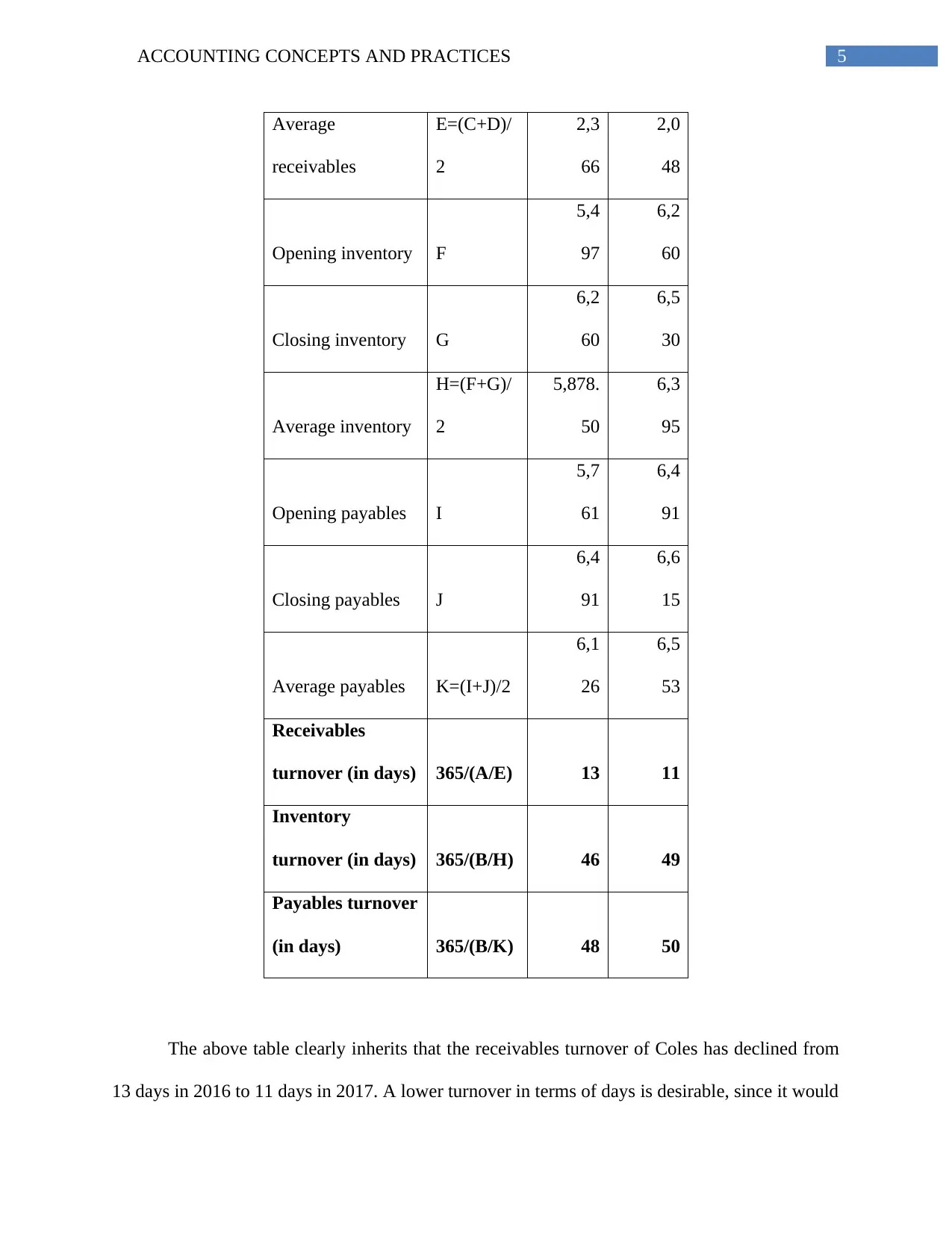
5ACCOUNTING CONCEPTS AND PRACTICES
Average
receivables
E=(C+D)/
2
2,3
66
2,0
48
Opening inventory F
5,4
97
6,2
60
Closing inventory G
6,2
60
6,5
30
Average inventory
H=(F+G)/
2
5,878.
50
6,3
95
Opening payables I
5,7
61
6,4
91
Closing payables J
6,4
91
6,6
15
Average payables K=(I+J)/2
6,1
26
6,5
53
Receivables
turnover (in days) 365/(A/E) 13 11
Inventory
turnover (in days) 365/(B/H) 46 49
Payables turnover
(in days) 365/(B/K) 48 50
The above table clearly inherits that the receivables turnover of Coles has declined from
13 days in 2016 to 11 days in 2017. A lower turnover in terms of days is desirable, since it would
Average
receivables
E=(C+D)/
2
2,3
66
2,0
48
Opening inventory F
5,4
97
6,2
60
Closing inventory G
6,2
60
6,5
30
Average inventory
H=(F+G)/
2
5,878.
50
6,3
95
Opening payables I
5,7
61
6,4
91
Closing payables J
6,4
91
6,6
15
Average payables K=(I+J)/2
6,1
26
6,5
53
Receivables
turnover (in days) 365/(A/E) 13 11
Inventory
turnover (in days) 365/(B/H) 46 49
Payables turnover
(in days) 365/(B/K) 48 50
The above table clearly inherits that the receivables turnover of Coles has declined from
13 days in 2016 to 11 days in 2017. A lower turnover in terms of days is desirable, since it would
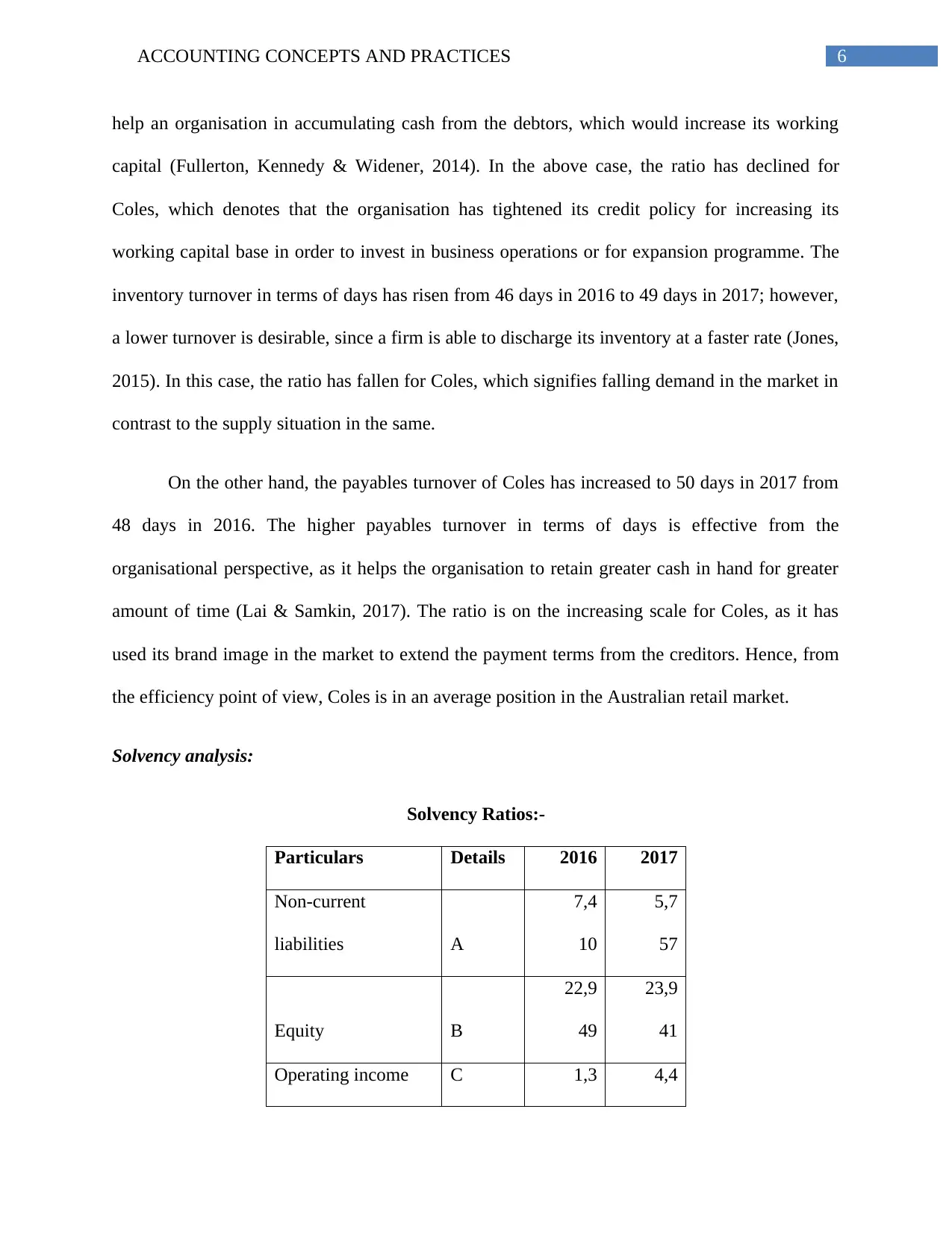
6ACCOUNTING CONCEPTS AND PRACTICES
help an organisation in accumulating cash from the debtors, which would increase its working
capital (Fullerton, Kennedy & Widener, 2014). In the above case, the ratio has declined for
Coles, which denotes that the organisation has tightened its credit policy for increasing its
working capital base in order to invest in business operations or for expansion programme. The
inventory turnover in terms of days has risen from 46 days in 2016 to 49 days in 2017; however,
a lower turnover is desirable, since a firm is able to discharge its inventory at a faster rate (Jones,
2015). In this case, the ratio has fallen for Coles, which signifies falling demand in the market in
contrast to the supply situation in the same.
On the other hand, the payables turnover of Coles has increased to 50 days in 2017 from
48 days in 2016. The higher payables turnover in terms of days is effective from the
organisational perspective, as it helps the organisation to retain greater cash in hand for greater
amount of time (Lai & Samkin, 2017). The ratio is on the increasing scale for Coles, as it has
used its brand image in the market to extend the payment terms from the creditors. Hence, from
the efficiency point of view, Coles is in an average position in the Australian retail market.
Solvency analysis:
Solvency Ratios:-
Particulars Details 2016 2017
Non-current
liabilities A
7,4
10
5,7
57
Equity B
22,9
49
23,9
41
Operating income C 1,3 4,4
help an organisation in accumulating cash from the debtors, which would increase its working
capital (Fullerton, Kennedy & Widener, 2014). In the above case, the ratio has declined for
Coles, which denotes that the organisation has tightened its credit policy for increasing its
working capital base in order to invest in business operations or for expansion programme. The
inventory turnover in terms of days has risen from 46 days in 2016 to 49 days in 2017; however,
a lower turnover is desirable, since a firm is able to discharge its inventory at a faster rate (Jones,
2015). In this case, the ratio has fallen for Coles, which signifies falling demand in the market in
contrast to the supply situation in the same.
On the other hand, the payables turnover of Coles has increased to 50 days in 2017 from
48 days in 2016. The higher payables turnover in terms of days is effective from the
organisational perspective, as it helps the organisation to retain greater cash in hand for greater
amount of time (Lai & Samkin, 2017). The ratio is on the increasing scale for Coles, as it has
used its brand image in the market to extend the payment terms from the creditors. Hence, from
the efficiency point of view, Coles is in an average position in the Australian retail market.
Solvency analysis:
Solvency Ratios:-
Particulars Details 2016 2017
Non-current
liabilities A
7,4
10
5,7
57
Equity B
22,9
49
23,9
41
Operating income C 1,3 4,4
Paraphrase This Document
Need a fresh take? Get an instant paraphrase of this document with our AI Paraphraser
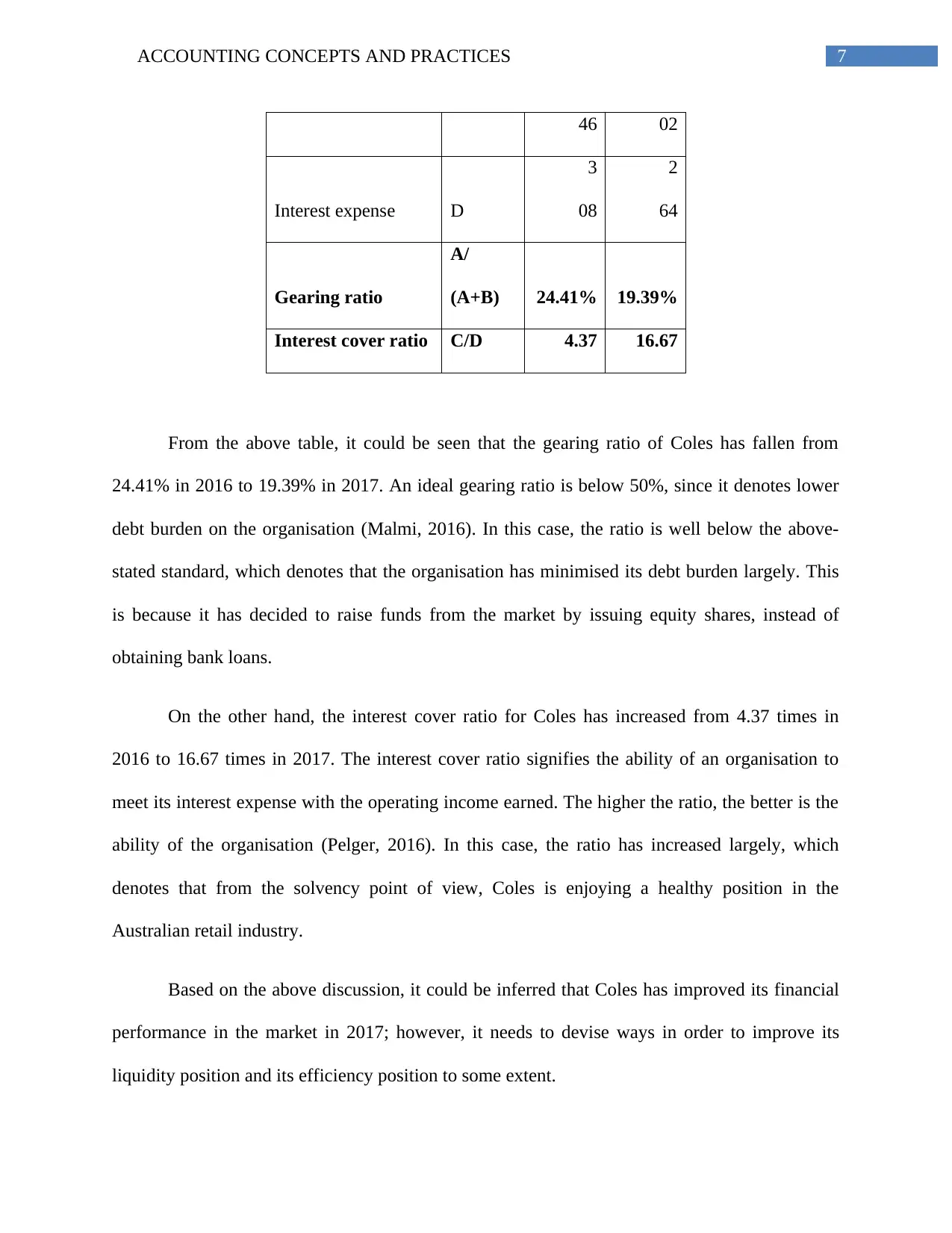
7ACCOUNTING CONCEPTS AND PRACTICES
46 02
Interest expense D
3
08
2
64
Gearing ratio
A/
(A+B) 24.41% 19.39%
Interest cover ratio C/D 4.37 16.67
From the above table, it could be seen that the gearing ratio of Coles has fallen from
24.41% in 2016 to 19.39% in 2017. An ideal gearing ratio is below 50%, since it denotes lower
debt burden on the organisation (Malmi, 2016). In this case, the ratio is well below the above-
stated standard, which denotes that the organisation has minimised its debt burden largely. This
is because it has decided to raise funds from the market by issuing equity shares, instead of
obtaining bank loans.
On the other hand, the interest cover ratio for Coles has increased from 4.37 times in
2016 to 16.67 times in 2017. The interest cover ratio signifies the ability of an organisation to
meet its interest expense with the operating income earned. The higher the ratio, the better is the
ability of the organisation (Pelger, 2016). In this case, the ratio has increased largely, which
denotes that from the solvency point of view, Coles is enjoying a healthy position in the
Australian retail industry.
Based on the above discussion, it could be inferred that Coles has improved its financial
performance in the market in 2017; however, it needs to devise ways in order to improve its
liquidity position and its efficiency position to some extent.
46 02
Interest expense D
3
08
2
64
Gearing ratio
A/
(A+B) 24.41% 19.39%
Interest cover ratio C/D 4.37 16.67
From the above table, it could be seen that the gearing ratio of Coles has fallen from
24.41% in 2016 to 19.39% in 2017. An ideal gearing ratio is below 50%, since it denotes lower
debt burden on the organisation (Malmi, 2016). In this case, the ratio is well below the above-
stated standard, which denotes that the organisation has minimised its debt burden largely. This
is because it has decided to raise funds from the market by issuing equity shares, instead of
obtaining bank loans.
On the other hand, the interest cover ratio for Coles has increased from 4.37 times in
2016 to 16.67 times in 2017. The interest cover ratio signifies the ability of an organisation to
meet its interest expense with the operating income earned. The higher the ratio, the better is the
ability of the organisation (Pelger, 2016). In this case, the ratio has increased largely, which
denotes that from the solvency point of view, Coles is enjoying a healthy position in the
Australian retail industry.
Based on the above discussion, it could be inferred that Coles has improved its financial
performance in the market in 2017; however, it needs to devise ways in order to improve its
liquidity position and its efficiency position to some extent.
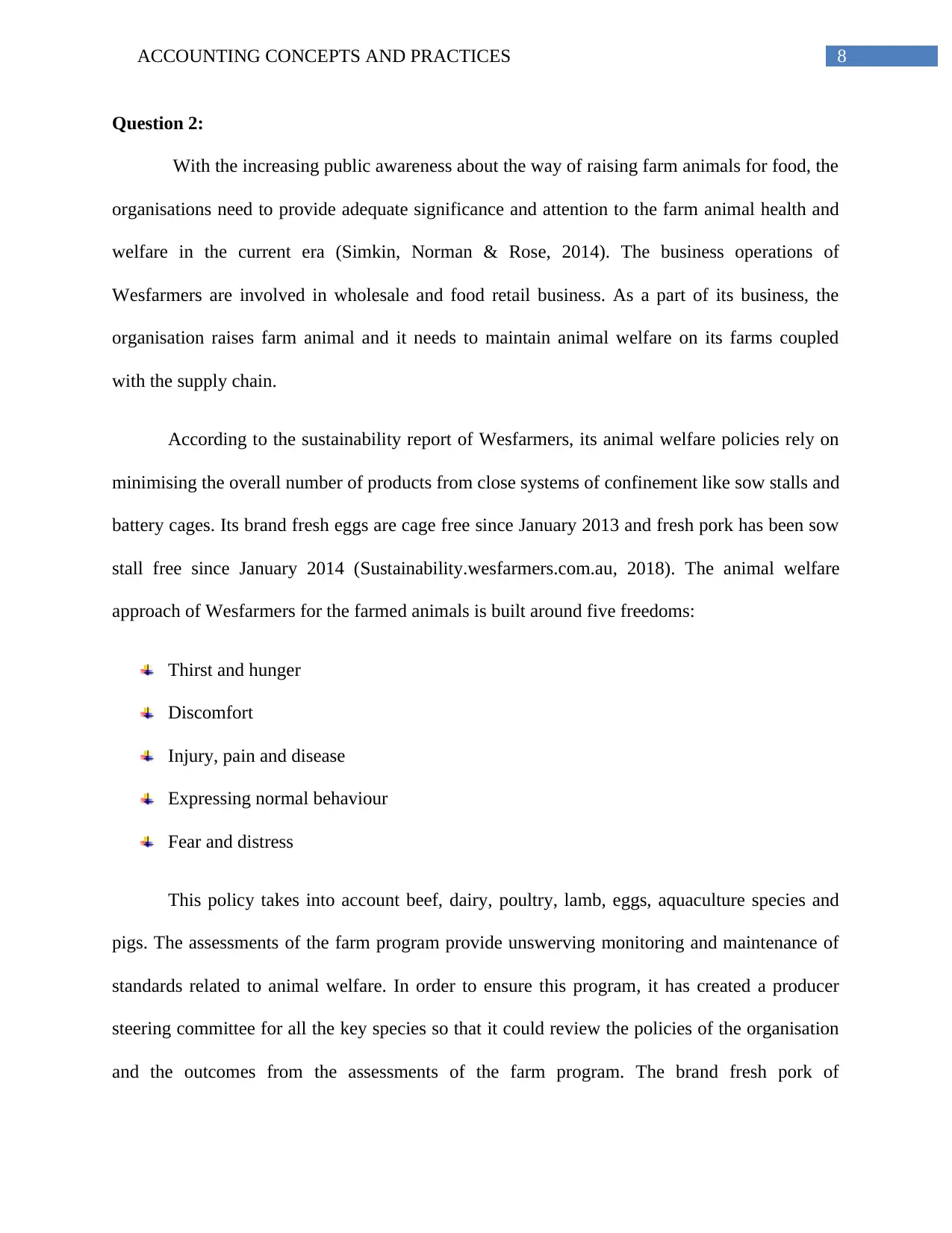
8ACCOUNTING CONCEPTS AND PRACTICES
Question 2:
With the increasing public awareness about the way of raising farm animals for food, the
organisations need to provide adequate significance and attention to the farm animal health and
welfare in the current era (Simkin, Norman & Rose, 2014). The business operations of
Wesfarmers are involved in wholesale and food retail business. As a part of its business, the
organisation raises farm animal and it needs to maintain animal welfare on its farms coupled
with the supply chain.
According to the sustainability report of Wesfarmers, its animal welfare policies rely on
minimising the overall number of products from close systems of confinement like sow stalls and
battery cages. Its brand fresh eggs are cage free since January 2013 and fresh pork has been sow
stall free since January 2014 (Sustainability.wesfarmers.com.au, 2018). The animal welfare
approach of Wesfarmers for the farmed animals is built around five freedoms:
Thirst and hunger
Discomfort
Injury, pain and disease
Expressing normal behaviour
Fear and distress
This policy takes into account beef, dairy, poultry, lamb, eggs, aquaculture species and
pigs. The assessments of the farm program provide unswerving monitoring and maintenance of
standards related to animal welfare. In order to ensure this program, it has created a producer
steering committee for all the key species so that it could review the policies of the organisation
and the outcomes from the assessments of the farm program. The brand fresh pork of
Question 2:
With the increasing public awareness about the way of raising farm animals for food, the
organisations need to provide adequate significance and attention to the farm animal health and
welfare in the current era (Simkin, Norman & Rose, 2014). The business operations of
Wesfarmers are involved in wholesale and food retail business. As a part of its business, the
organisation raises farm animal and it needs to maintain animal welfare on its farms coupled
with the supply chain.
According to the sustainability report of Wesfarmers, its animal welfare policies rely on
minimising the overall number of products from close systems of confinement like sow stalls and
battery cages. Its brand fresh eggs are cage free since January 2013 and fresh pork has been sow
stall free since January 2014 (Sustainability.wesfarmers.com.au, 2018). The animal welfare
approach of Wesfarmers for the farmed animals is built around five freedoms:
Thirst and hunger
Discomfort
Injury, pain and disease
Expressing normal behaviour
Fear and distress
This policy takes into account beef, dairy, poultry, lamb, eggs, aquaculture species and
pigs. The assessments of the farm program provide unswerving monitoring and maintenance of
standards related to animal welfare. In order to ensure this program, it has created a producer
steering committee for all the key species so that it could review the policies of the organisation
and the outcomes from the assessments of the farm program. The brand fresh pork of
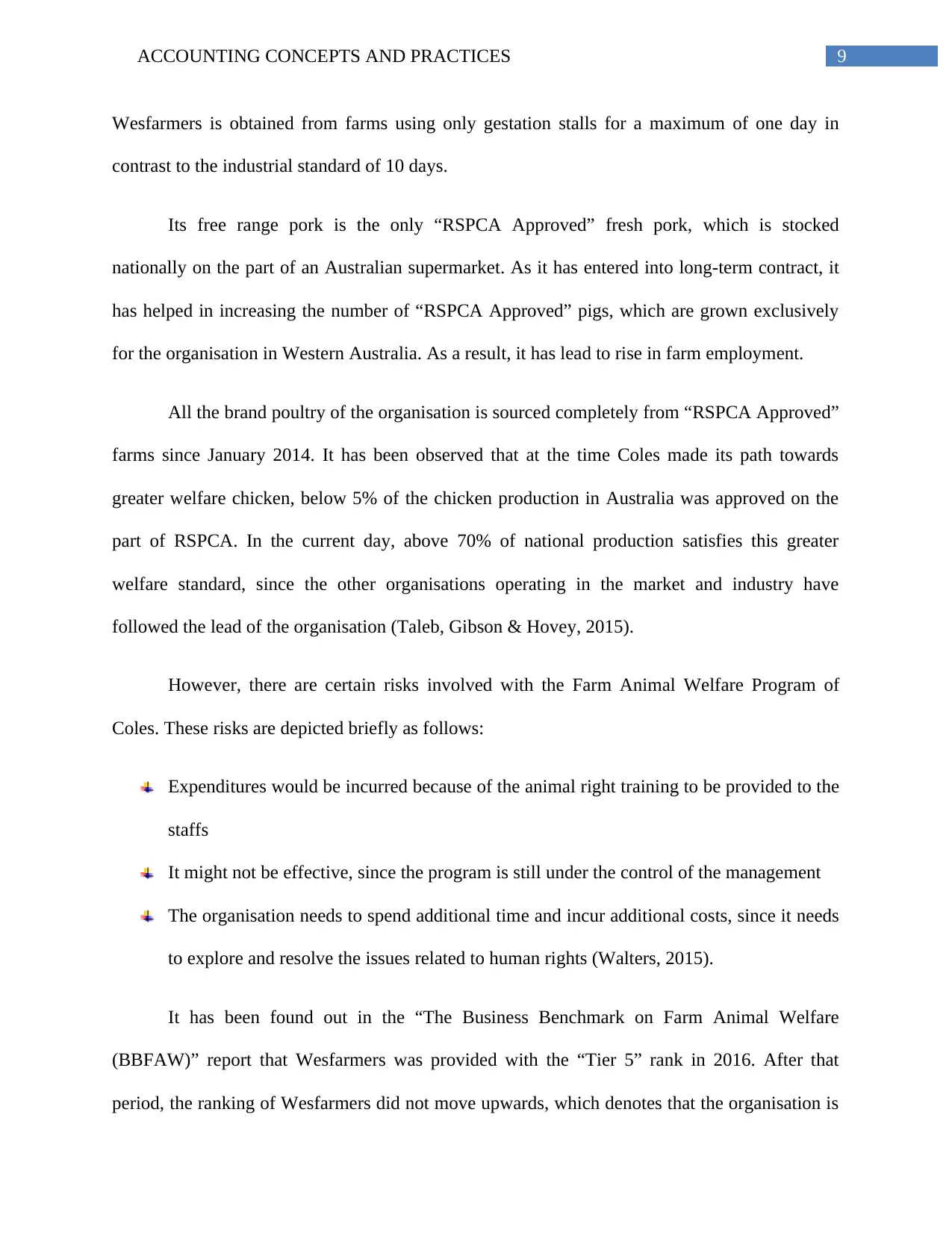
9ACCOUNTING CONCEPTS AND PRACTICES
Wesfarmers is obtained from farms using only gestation stalls for a maximum of one day in
contrast to the industrial standard of 10 days.
Its free range pork is the only “RSPCA Approved” fresh pork, which is stocked
nationally on the part of an Australian supermarket. As it has entered into long-term contract, it
has helped in increasing the number of “RSPCA Approved” pigs, which are grown exclusively
for the organisation in Western Australia. As a result, it has lead to rise in farm employment.
All the brand poultry of the organisation is sourced completely from “RSPCA Approved”
farms since January 2014. It has been observed that at the time Coles made its path towards
greater welfare chicken, below 5% of the chicken production in Australia was approved on the
part of RSPCA. In the current day, above 70% of national production satisfies this greater
welfare standard, since the other organisations operating in the market and industry have
followed the lead of the organisation (Taleb, Gibson & Hovey, 2015).
However, there are certain risks involved with the Farm Animal Welfare Program of
Coles. These risks are depicted briefly as follows:
Expenditures would be incurred because of the animal right training to be provided to the
staffs
It might not be effective, since the program is still under the control of the management
The organisation needs to spend additional time and incur additional costs, since it needs
to explore and resolve the issues related to human rights (Walters, 2015).
It has been found out in the “The Business Benchmark on Farm Animal Welfare
(BBFAW)” report that Wesfarmers was provided with the “Tier 5” rank in 2016. After that
period, the ranking of Wesfarmers did not move upwards, which denotes that the organisation is
Wesfarmers is obtained from farms using only gestation stalls for a maximum of one day in
contrast to the industrial standard of 10 days.
Its free range pork is the only “RSPCA Approved” fresh pork, which is stocked
nationally on the part of an Australian supermarket. As it has entered into long-term contract, it
has helped in increasing the number of “RSPCA Approved” pigs, which are grown exclusively
for the organisation in Western Australia. As a result, it has lead to rise in farm employment.
All the brand poultry of the organisation is sourced completely from “RSPCA Approved”
farms since January 2014. It has been observed that at the time Coles made its path towards
greater welfare chicken, below 5% of the chicken production in Australia was approved on the
part of RSPCA. In the current day, above 70% of national production satisfies this greater
welfare standard, since the other organisations operating in the market and industry have
followed the lead of the organisation (Taleb, Gibson & Hovey, 2015).
However, there are certain risks involved with the Farm Animal Welfare Program of
Coles. These risks are depicted briefly as follows:
Expenditures would be incurred because of the animal right training to be provided to the
staffs
It might not be effective, since the program is still under the control of the management
The organisation needs to spend additional time and incur additional costs, since it needs
to explore and resolve the issues related to human rights (Walters, 2015).
It has been found out in the “The Business Benchmark on Farm Animal Welfare
(BBFAW)” report that Wesfarmers was provided with the “Tier 5” rank in 2016. After that
period, the ranking of Wesfarmers did not move upwards, which denotes that the organisation is
Secure Best Marks with AI Grader
Need help grading? Try our AI Grader for instant feedback on your assignments.

10ACCOUNTING CONCEPTS AND PRACTICES
on the process of business agenda; however, the evidence of implementation is limited. This is
because of the following reasons:
Use of antibiotics for preventing infections in stressed animals, which has increased
animal growth.
Use of antibiotics in food-producing animals, which is not ideal for animal welfare and
human health.
Hence, it could be inferred that the organisation has lost marks under the category of
animals’ right and it could be rated under Tier 5.
Question 3:
Part A:
Fig and Olive Inc
Adjusting Journal
30 June 2017
Date Particular L Ref Debit Credit
01 Depreciation Expense – Plant &
Equipment(120000-
20000*25/100+20000*25/100*3/12)
26250
Accumulated Depreciation- Plant &
Equipment
26250
on the process of business agenda; however, the evidence of implementation is limited. This is
because of the following reasons:
Use of antibiotics for preventing infections in stressed animals, which has increased
animal growth.
Use of antibiotics in food-producing animals, which is not ideal for animal welfare and
human health.
Hence, it could be inferred that the organisation has lost marks under the category of
animals’ right and it could be rated under Tier 5.
Question 3:
Part A:
Fig and Olive Inc
Adjusting Journal
30 June 2017
Date Particular L Ref Debit Credit
01 Depreciation Expense – Plant &
Equipment(120000-
20000*25/100+20000*25/100*3/12)
26250
Accumulated Depreciation- Plant &
Equipment
26250
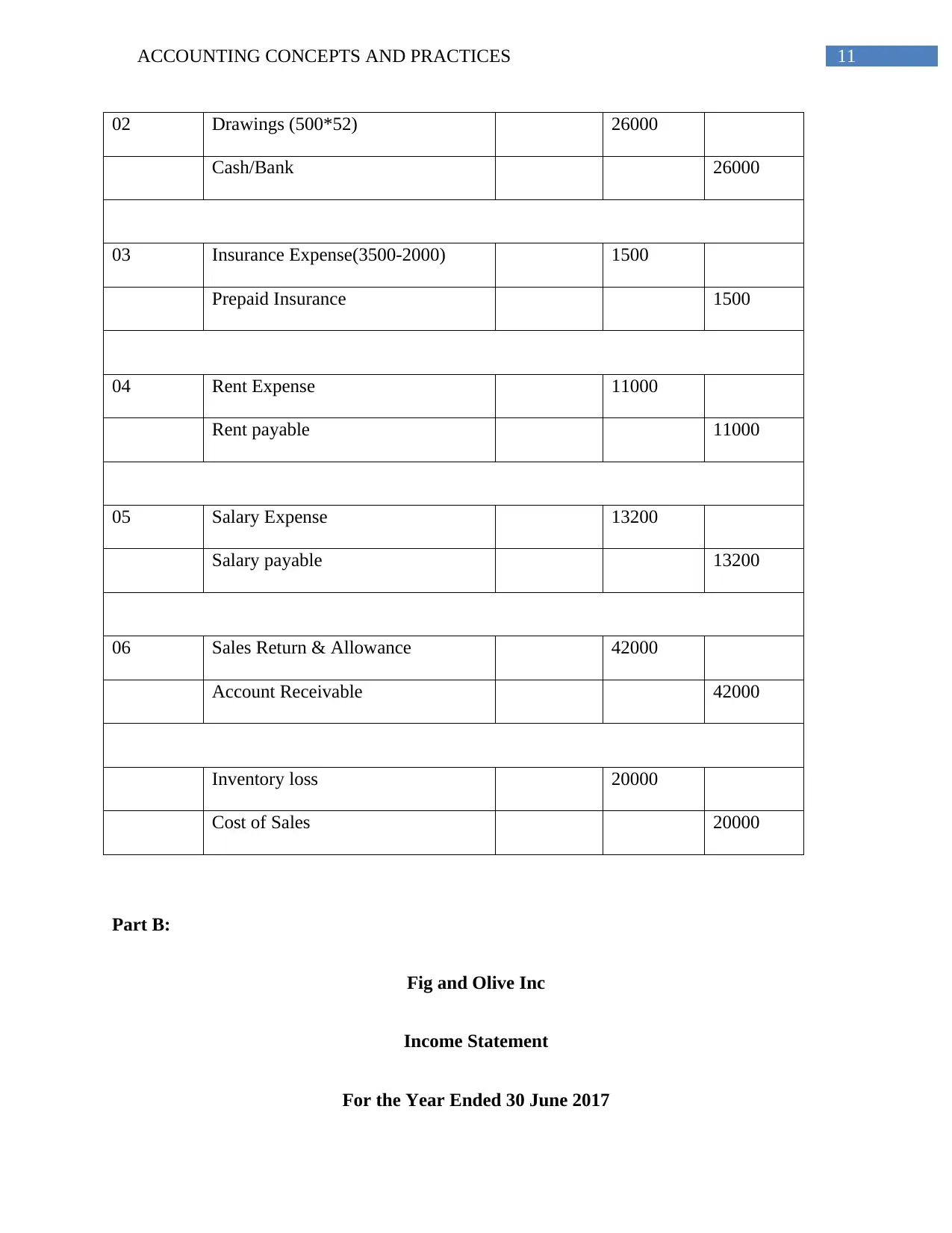
11ACCOUNTING CONCEPTS AND PRACTICES
02 Drawings (500*52) 26000
Cash/Bank 26000
03 Insurance Expense(3500-2000) 1500
Prepaid Insurance 1500
04 Rent Expense 11000
Rent payable 11000
05 Salary Expense 13200
Salary payable 13200
06 Sales Return & Allowance 42000
Account Receivable 42000
Inventory loss 20000
Cost of Sales 20000
Part B:
Fig and Olive Inc
Income Statement
For the Year Ended 30 June 2017
02 Drawings (500*52) 26000
Cash/Bank 26000
03 Insurance Expense(3500-2000) 1500
Prepaid Insurance 1500
04 Rent Expense 11000
Rent payable 11000
05 Salary Expense 13200
Salary payable 13200
06 Sales Return & Allowance 42000
Account Receivable 42000
Inventory loss 20000
Cost of Sales 20000
Part B:
Fig and Olive Inc
Income Statement
For the Year Ended 30 June 2017
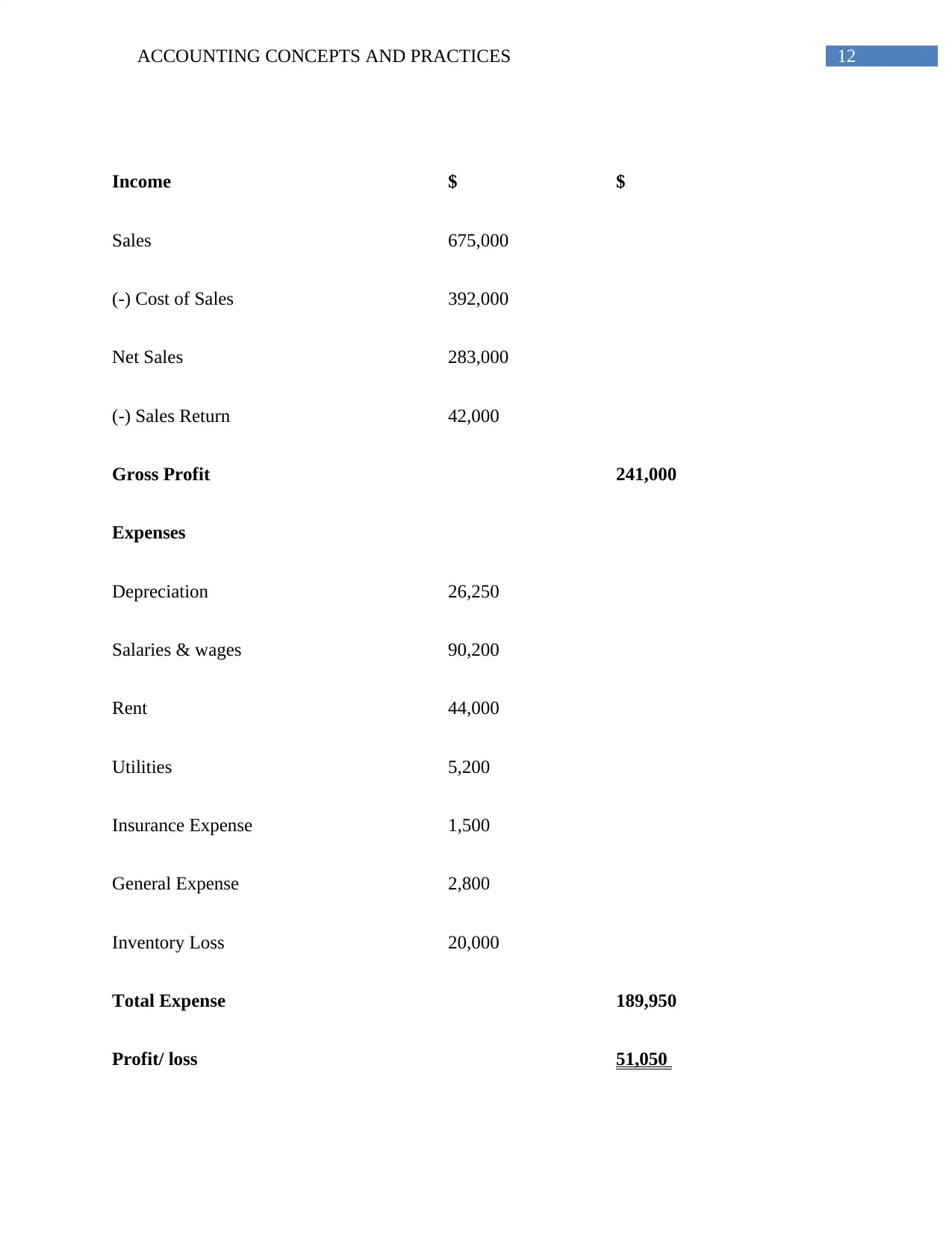
12ACCOUNTING CONCEPTS AND PRACTICES
Income $ $
Sales 675,000
(-) Cost of Sales 392,000
Net Sales 283,000
(-) Sales Return 42,000
Gross Profit 241,000
Expenses
Depreciation 26,250
Salaries & wages 90,200
Rent 44,000
Utilities 5,200
Insurance Expense 1,500
General Expense 2,800
Inventory Loss 20,000
Total Expense 189,950
Profit/ loss 51,050
Income $ $
Sales 675,000
(-) Cost of Sales 392,000
Net Sales 283,000
(-) Sales Return 42,000
Gross Profit 241,000
Expenses
Depreciation 26,250
Salaries & wages 90,200
Rent 44,000
Utilities 5,200
Insurance Expense 1,500
General Expense 2,800
Inventory Loss 20,000
Total Expense 189,950
Profit/ loss 51,050
Paraphrase This Document
Need a fresh take? Get an instant paraphrase of this document with our AI Paraphraser

13ACCOUNTING CONCEPTS AND PRACTICES
Fig and Olive Inc
Statement of Changes in Equity
For the Year Ended 30 June 2017
Fig and Olive Capital 01 July 2016 310,000
(+) Profit/ Loss 51,050
(-)Fig and Olive Drawing (63300+26000) 89,300
Fig and Olive Capital 30 June 2017 271,750
Part C:
Fig and Olive Inc
Statement of Financial Position
As at 30 June 2017
Assets:
Current Assets
Cash at Bank (20,300-26,000) (5,700)
Account Receivable (45200-42,000) 3200
Inventory (180,300-20,000) 160,300
Fig and Olive Inc
Statement of Changes in Equity
For the Year Ended 30 June 2017
Fig and Olive Capital 01 July 2016 310,000
(+) Profit/ Loss 51,050
(-)Fig and Olive Drawing (63300+26000) 89,300
Fig and Olive Capital 30 June 2017 271,750
Part C:
Fig and Olive Inc
Statement of Financial Position
As at 30 June 2017
Assets:
Current Assets
Cash at Bank (20,300-26,000) (5,700)
Account Receivable (45200-42,000) 3200
Inventory (180,300-20,000) 160,300
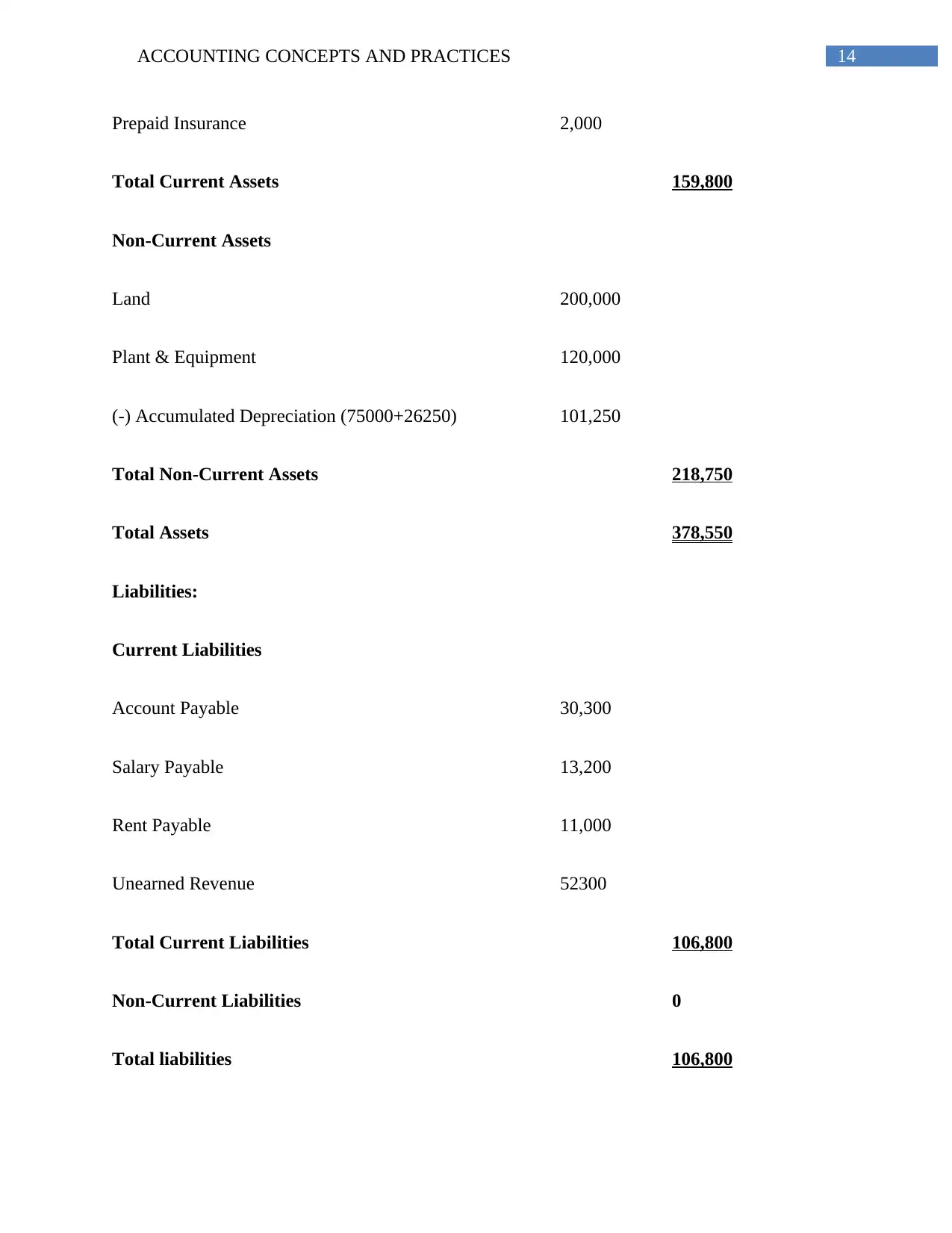
14ACCOUNTING CONCEPTS AND PRACTICES
Prepaid Insurance 2,000
Total Current Assets 159,800
Non-Current Assets
Land 200,000
Plant & Equipment 120,000
(-) Accumulated Depreciation (75000+26250) 101,250
Total Non-Current Assets 218,750
Total Assets 378,550
Liabilities:
Current Liabilities
Account Payable 30,300
Salary Payable 13,200
Rent Payable 11,000
Unearned Revenue 52300
Total Current Liabilities 106,800
Non-Current Liabilities 0
Total liabilities 106,800
Prepaid Insurance 2,000
Total Current Assets 159,800
Non-Current Assets
Land 200,000
Plant & Equipment 120,000
(-) Accumulated Depreciation (75000+26250) 101,250
Total Non-Current Assets 218,750
Total Assets 378,550
Liabilities:
Current Liabilities
Account Payable 30,300
Salary Payable 13,200
Rent Payable 11,000
Unearned Revenue 52300
Total Current Liabilities 106,800
Non-Current Liabilities 0
Total liabilities 106,800
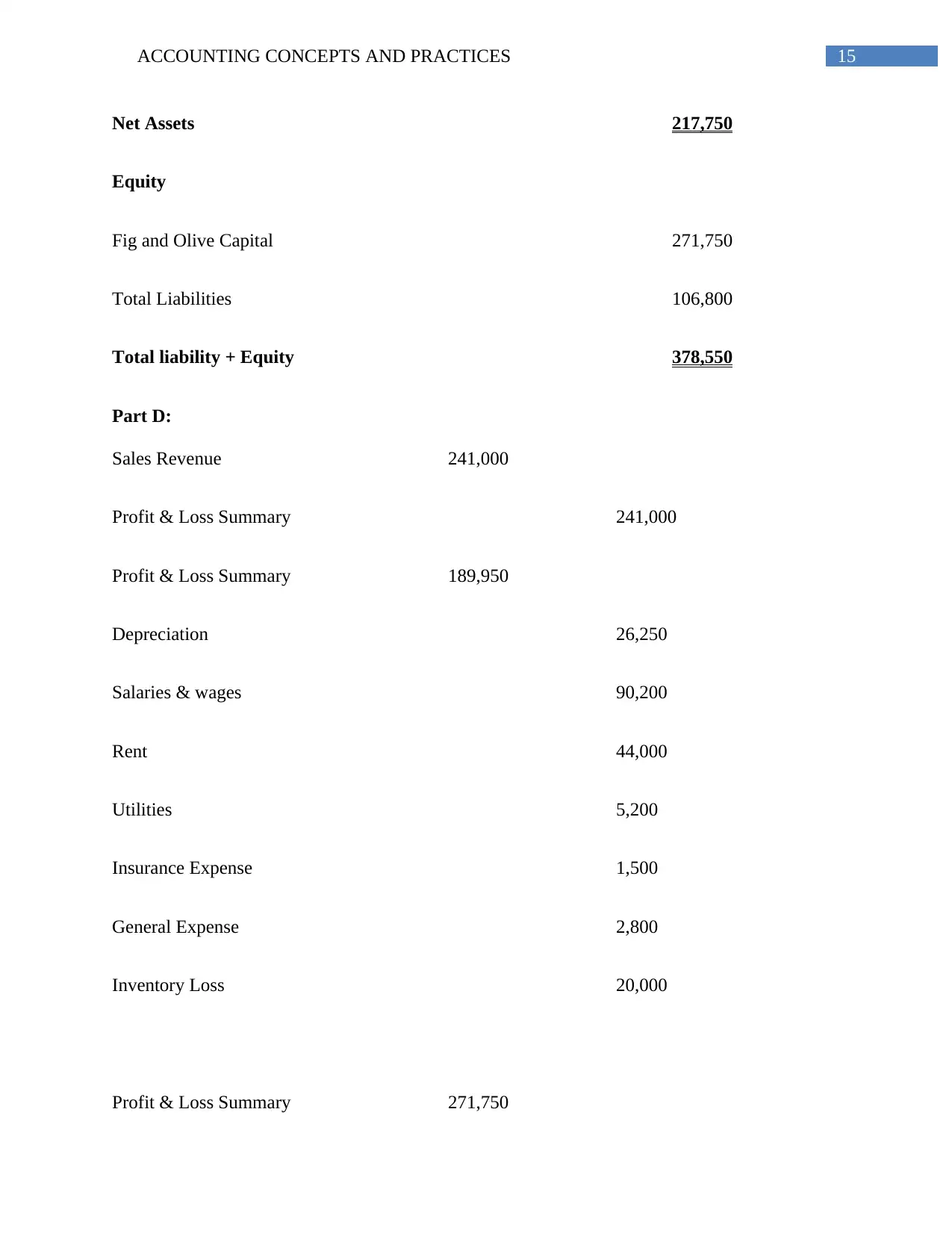
15ACCOUNTING CONCEPTS AND PRACTICES
Net Assets 217,750
Equity
Fig and Olive Capital 271,750
Total Liabilities 106,800
Total liability + Equity 378,550
Part D:
Sales Revenue 241,000
Profit & Loss Summary 241,000
Profit & Loss Summary 189,950
Depreciation 26,250
Salaries & wages 90,200
Rent 44,000
Utilities 5,200
Insurance Expense 1,500
General Expense 2,800
Inventory Loss 20,000
Profit & Loss Summary 271,750
Net Assets 217,750
Equity
Fig and Olive Capital 271,750
Total Liabilities 106,800
Total liability + Equity 378,550
Part D:
Sales Revenue 241,000
Profit & Loss Summary 241,000
Profit & Loss Summary 189,950
Depreciation 26,250
Salaries & wages 90,200
Rent 44,000
Utilities 5,200
Insurance Expense 1,500
General Expense 2,800
Inventory Loss 20,000
Profit & Loss Summary 271,750
Secure Best Marks with AI Grader
Need help grading? Try our AI Grader for instant feedback on your assignments.

16ACCOUNTING CONCEPTS AND PRACTICES
Fig and Olive Capital 271,750
Fig and Olive Capital 89,300
Fig and Olive Drawing 89,300
Fig and Olive Capital 271,750
Fig and Olive Capital 89,300
Fig and Olive Drawing 89,300
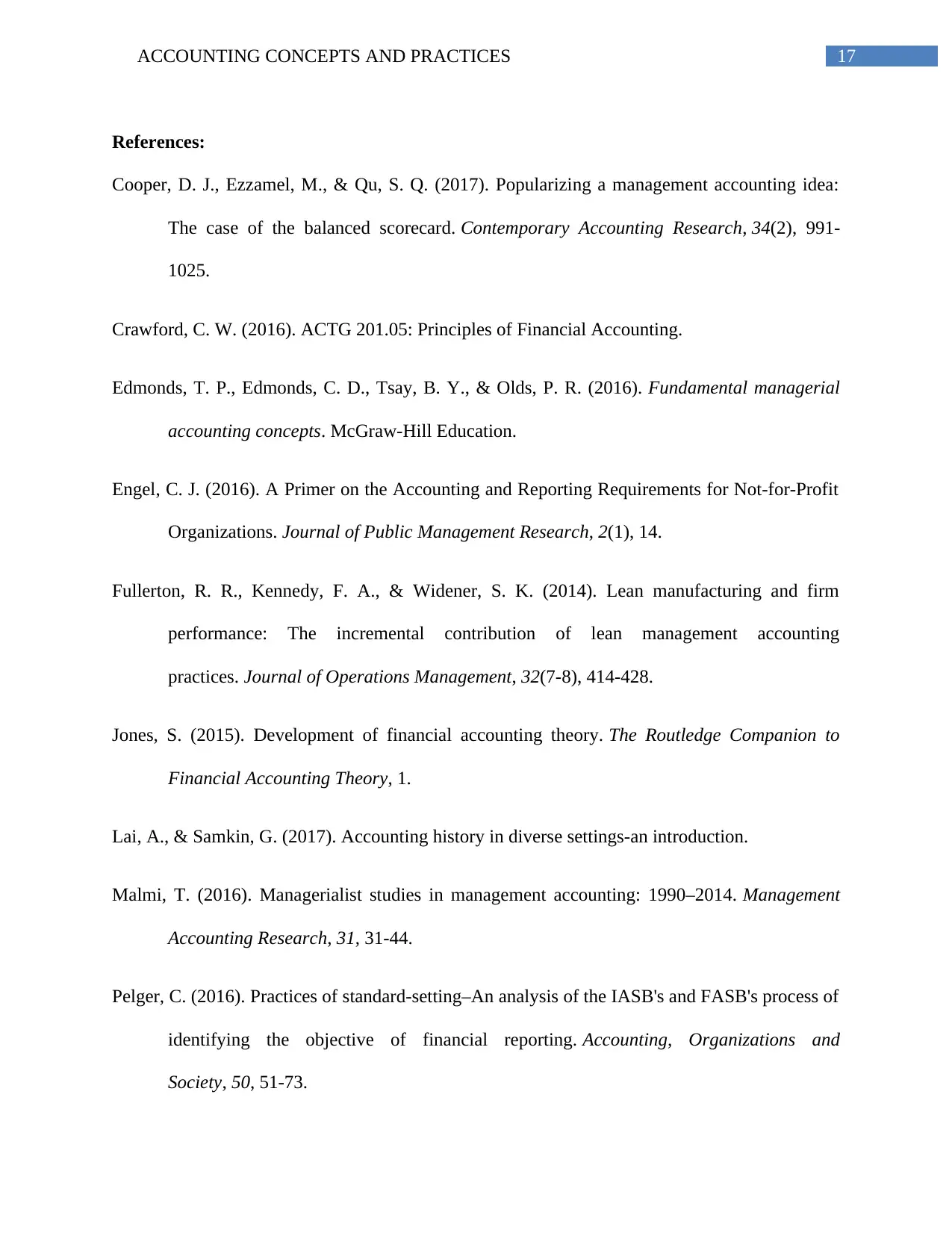
17ACCOUNTING CONCEPTS AND PRACTICES
References:
Cooper, D. J., Ezzamel, M., & Qu, S. Q. (2017). Popularizing a management accounting idea:
The case of the balanced scorecard. Contemporary Accounting Research, 34(2), 991-
1025.
Crawford, C. W. (2016). ACTG 201.05: Principles of Financial Accounting.
Edmonds, T. P., Edmonds, C. D., Tsay, B. Y., & Olds, P. R. (2016). Fundamental managerial
accounting concepts. McGraw-Hill Education.
Engel, C. J. (2016). A Primer on the Accounting and Reporting Requirements for Not-for-Profit
Organizations. Journal of Public Management Research, 2(1), 14.
Fullerton, R. R., Kennedy, F. A., & Widener, S. K. (2014). Lean manufacturing and firm
performance: The incremental contribution of lean management accounting
practices. Journal of Operations Management, 32(7-8), 414-428.
Jones, S. (2015). Development of financial accounting theory. The Routledge Companion to
Financial Accounting Theory, 1.
Lai, A., & Samkin, G. (2017). Accounting history in diverse settings-an introduction.
Malmi, T. (2016). Managerialist studies in management accounting: 1990–2014. Management
Accounting Research, 31, 31-44.
Pelger, C. (2016). Practices of standard-setting–An analysis of the IASB's and FASB's process of
identifying the objective of financial reporting. Accounting, Organizations and
Society, 50, 51-73.
References:
Cooper, D. J., Ezzamel, M., & Qu, S. Q. (2017). Popularizing a management accounting idea:
The case of the balanced scorecard. Contemporary Accounting Research, 34(2), 991-
1025.
Crawford, C. W. (2016). ACTG 201.05: Principles of Financial Accounting.
Edmonds, T. P., Edmonds, C. D., Tsay, B. Y., & Olds, P. R. (2016). Fundamental managerial
accounting concepts. McGraw-Hill Education.
Engel, C. J. (2016). A Primer on the Accounting and Reporting Requirements for Not-for-Profit
Organizations. Journal of Public Management Research, 2(1), 14.
Fullerton, R. R., Kennedy, F. A., & Widener, S. K. (2014). Lean manufacturing and firm
performance: The incremental contribution of lean management accounting
practices. Journal of Operations Management, 32(7-8), 414-428.
Jones, S. (2015). Development of financial accounting theory. The Routledge Companion to
Financial Accounting Theory, 1.
Lai, A., & Samkin, G. (2017). Accounting history in diverse settings-an introduction.
Malmi, T. (2016). Managerialist studies in management accounting: 1990–2014. Management
Accounting Research, 31, 31-44.
Pelger, C. (2016). Practices of standard-setting–An analysis of the IASB's and FASB's process of
identifying the objective of financial reporting. Accounting, Organizations and
Society, 50, 51-73.
1 out of 18
Related Documents
Your All-in-One AI-Powered Toolkit for Academic Success.
+13062052269
info@desklib.com
Available 24*7 on WhatsApp / Email
![[object Object]](/_next/static/media/star-bottom.7253800d.svg)
Unlock your academic potential
© 2024 | Zucol Services PVT LTD | All rights reserved.





